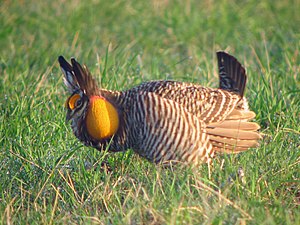 |
| (Photo credit: Wikipedia) |
WAH-KON-TAH PRAIRIE, Mo. --
Greater
prairie chickens, missing for some years among the grasses at
Wah-Kon-Tah Prairie, strutted and boomed again this spring in an
eons-old mating ritual. Biologists, digging deep
in grassland ecology to save the species in Missouri, brought them
back. Now, they watch to see if this iconic but state-endangered member
of the grouse family can be restored long-term to prairies where they
once thrived.
“Hopeful
is the right word,” said Max Alleger, grassland bird coordinator for
the Missouri Department of Conservation (MDC). “Perhaps our biggest
question
is whether intensive management can in the long run balance the fact
that our grasslands are limited in size. Do we have enough grasslands to
support prairie chickens on the landscape?”
A
five-year translocation project by MDC to help answer the question
concluded in April. MDC crews trapped Kansas prairie chickens where they
are plentiful
in the grassy Smoky Hills. Biologists then gave the birds leg bands and
tiny radio transmitters before releasing them at Wah-Kon-Tah’s native
grasslands north of El Dorado Springs.
Those
prairie chickens will help land managers serve the species. Observers
track the birds’ movements visually or via radio telemetry. Results tell
researchers
how habitat management can help the ground-dwelling birds sustain
populations.
“In
the last five years, I’ve learned a lot about prairie chickens from
this study,” said Len Gilmore, an MDC wildlife management biologist
based in El Dorado.
“They like hanging out in the short grasses and feeding there, and they
go to our prairies with taller grasses to roost at night.”
Prairie
chickens this spring used three leks – courtship and mating sites – at
the 3,000-acre Wah-Kon-Tah Prairie in St. Clair and Cedar counties. Some
courting
males and females were hatched and reared on the area, an encouraging
sign that reproduction is occurring.
“The
number of leks indicates the population is increasing,” Gilmore said.
“They’re breaking off and forming new booming grounds.”
Prairie
chickens once numbered in the hundreds of thousands in Missouri on
wide-open grasslands and areas mixed with native trees, wildflowers and
grasses.
But cities, farming and fire suppression during the past two centuries
altered landscapes the birds evolved upon.
Today,
less than one half of one percent of Missouri’s original prairie
remains, and those remnants are scattered. Prairie chicken flocks
endured into the
late 1900s on or near native grassland remnants in northern and western
Missouri. But in recent years their numbers plunged to critically low
levels – dozens rather than hundreds or thousands – and some flocks
vanished.
Low
reproduction due to poor weather conditions for nesting, habitat
decline and predators are suspected contributors to decline, biologists
theorize. Prairie
chickens have a high natural mortality rate, 50 percent or more
annually with birds generally living only a few years. Low numbers in
flocks means high risk for the species.
The
flocks living in the Wah-Kon-Tah area vanished by 2004. A small flock
using MDC’s Taberville Prairie Conservation Area about 10 miles away
survived in
low numbers.
MDC
began releasing Kansas prairie chickens at Wah-Kon-Tah in 2008 to see
if prairie chickens could be re-introduced to a landscape where they
once thrived.
This spring, 19 males and 44 females were released on the native and
restored grassland, which is a partnership between MDC and The Nature
Conservancy of Missouri.
The tracking study is providing answers about their habits and surprises.
A
landscape with diverse heights of grasses and forbs is important,
Gilmore said. Prairie chickens like to build nests on the ground in
taller cover. But
they don’t like to nest too far from shorter grasses where they and
chicks can easily move about, feed and rest. But 50 percent or more of
an area should have grasses tall enough to provide good nesting cover. A
lack of large quantities of high-quality nesting
cover may have led to prairie chicken declines.
The
study confirms that prairie chickens have a strong affinity for
“high-clipped” grasses, places where plants are tall enough for them to
duck and hide
in, but also short enough for them to raise their heads above and watch
for predators. Public land managers now use prescribed fire, cattle
grazing, mowing and haying to get the variety in grass heights that
prairie chickens prefer. Prairies or pastures left
to grow rank without disturbance don’t serve prairie chickens well.
A
surprise from the radio telemetry tracking is how far prairie chickens
move about on a landscape. They easily move 20 to 30 miles across
rivers, roads and
wooded fence rows. They won’t feed and roost on the ground near tree
lines but they will cross them on long journeys. One bird flew to Kansas
and then returned. Another spent the winter in a crop field in
northwestern Vernon County and then returned to Wah-Kan-Tah
for spring.
There
is surprising interaction between the flock at Wah-Kan-Tah and the one
at the Taberville prairie. Prairie chickens have also moved to other
prairie
remnants or traditional lek sites that have not had birds in recent
years, Gilmore said. The movement may be a species evolutionary survival
skill for mixing genetics. Their ability to navigate back and forth
across the countryside and their choices to settle
in at places that held prairie chickens years ago is uncanny.
One
concern was that with low numbers of prairie chickens, less genetic
diversity could cause fewer eggs to be laid by hens. But thus far,
clutch sizes are
healthy with 11 to 14 eggs in nests.
As
the translocation of Kansas birds ends, monitoring results are
prompting MDC biologists to provide more variation and diversity in
plant species and heights
than what occurred in past decades on public grasslands. Partnerships
with private landowners are also an important component in prairie
chicken recovery.








No comments:
Post a Comment